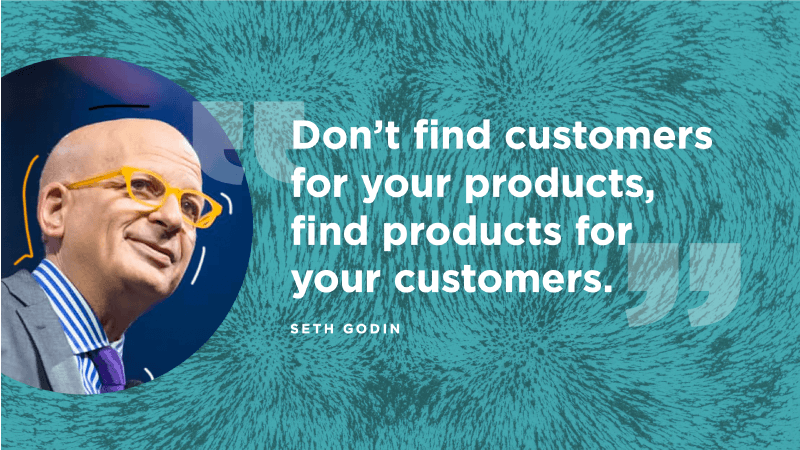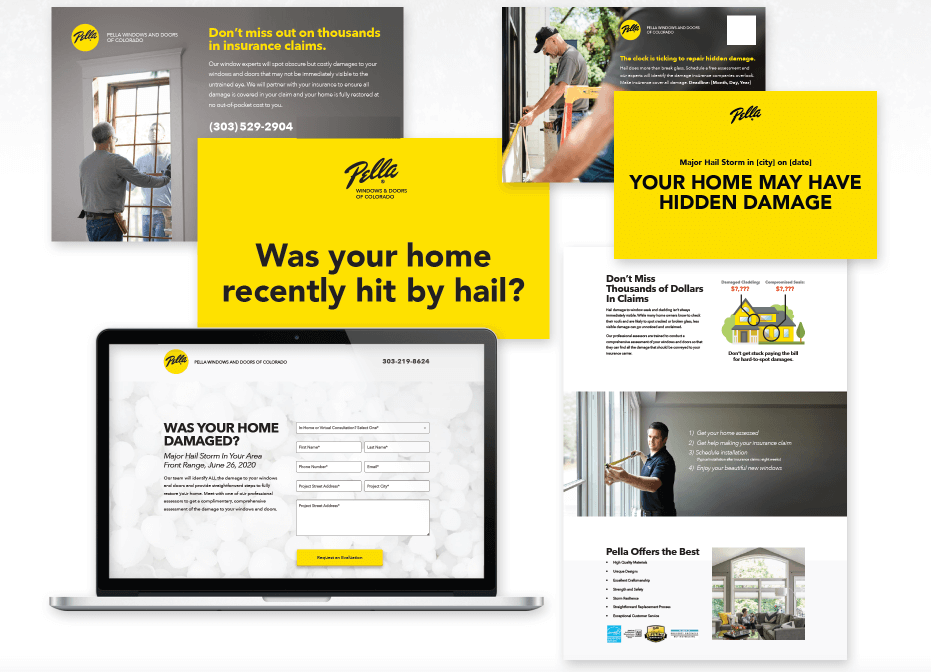5 Common Mistakes to Avoid for your Next Marketing Campaign
If you’ve been living in the marketing world long enough, you’ve likely run a campaign that didn’t knock your socks off.
Or was a downright disaster.
While trying and failing is simply part of the marketing game, we feel like it’s our duty to allow others to learn from the most common mistakes we see.
As they say… sometimes you win, sometimes you learn.
Over many years, our marketing team has dialed in a campaign planning process that helps ensure we have all the pieces in place before we begin.
We also have a super-simple checklist we use that – if done thoroughly – will prevent the flops you’re about to encounter.
In this blog, we’ll tell you about a few guaranteed pathways to doom. Another way of looking at these: avoid these common mistakes!
We’ll talk through what can go wrong, how to prevent said flops, and give you our two cents along the way.
Mistake #1: Ignore Your Audience
You don’t know their struggle, their needs, their deep, dark secrets.
What went wrong? Well, you skipped over the Persona phase in your strategy session and – quite frankly – your campaign doesn’t reflect that you actually know who you’re talking to.
In the words of Seth Godin, “Don’t find customers for your products, find products for your customers.”
Sometimes, we – as marketers – go at it backwards. We think, I have this amazing landing page. Let me drive some traffic to it.
Instead, we should be thinking, Here’s my target customer. What do they need? Let me learn from them.
If you obsess over your target audience – meaning, get to know them, empathize with them, understand what is haunting them – your content and offerings start to shape themselves. And they have much more impact.
Our advice? Glad you asked.
- Know your audience. Yes, it’s cliche, but true – we can always learn more and foster more empathy for the people we market to. Starting with a specific persona (use PCCPO as your strategy guide), you’ll uncover insights for everything else in your marketing campaign: product positioning, channels, content, and offers.
- Mind the gap. We tend to think our audience looks, feels, and thinks like us. However, for the most part, this simply isn’t true. We are not our customers and therefore we need to “mind the gap” between ourselves and them by engaging our empathetic forces and trying to think how they would. Often called the marketer’s dilemma, the big takeaway is that empathy and curiosity get you further than baseline assumptions.
- Eat a piece of humble pie. We have to admit that we aren’t the audience. Even if we’ve done this a thousand times, the numbers won’t lie! If it’s not working, be quick to respond, pivot, and try again (and that’s OK).
- Segment, segment, segment. Get ready to hear this a lot! While it’s difficult to segment well (especially if you have a mile-long list of emails), it is wildly valuable and efforts here tend to have a big payoff. Think through: Who is each persona and where did they come from? What do they care about? What are their priorities, concerns, hopes, dreams, fears, and worries? Then group them into categories that make the most sense based on their intentions.
Mistake #2: Boring Offers
This is what we call a boring offer.
The problem with a boring offer is that you likely didn’t think through – in-depth – an invitation that would be compelling, accessible, and helpful for your audience.
Maybe you simply didn’t allot time or money or creative juices to come up with an awesome offer.
If you’re taking the time to excite people, telling a great story, offering a solution that is going to change their lives, then you have to give them something to do with it! This is how you’ll capture leads and interest.
It’s not just about the offer itself, but the entire mechanism for responding – your offer should match the excitement of your campaign.
An Example of a Non-Boring Offer
An example of an engaging, successful offer might be helpful here. Here’s one from a Pella campaign our team knocked out of the park that was triggered directly after a hail storm:
- Get your home assessed for free
- Get any hidden damaged covered by your insurance company
- Get it fixed before your insurance company’s claim deadline is up
This offer was a win for Pella (more contracts) and a win for the consumer (get your house fixed and you don’t have to pay for it – your insurance will). Plus, it had urgency because there was a claims deadline that would expire if the consumer waited too long.
A la = a wildly successful offer, and a wildly successful campaign.
You may not always be able to create an offer that’s such a win-win, but it’s important that whatever you choose adds value to both your company AND the customer.
Here are a few tools to keep in your toolbelt so you can avoid creating boring offers:
- Buyer’s journey models: There are a ton of models surrounding the buyer’s journey and marketing funnels. These will help ensure your content and offers are relevant to where your buyers are at. Most of the models generally provide the same framework, so crafting your own version of a buyer’s journey with specifics on your target customers is helpful here. Remember: don’t assume that all of your buyers want the same offer – you can have different types of offers for different phases, and multiple offers for different audience segments within a single phase.
- Periodic Table of Content Marketing: This is a huge list of all of the types of content and offers you can create for your marketing campaigns. It’s like a shortcut …or a giant multiple choice questionnaire. Either way, it was built to make your life easier.
- PCCPO: At the end of the day, your target audience is only going to respond to your marketing campaign if you offer something that’s interesting to them. A good strategy process can help you identify your persona and align your offer with their interests.
A Quick Note on Offers: Be Prepared to Follow Through
If your company is a senior-living community in the middle of a global pandemic, you probably can’t invite the neighborhood on a tour.
Or, if you’re a software company offering free 30-day trials, you need to create a version of the software that will automatically require a subscription after 30 days.
Make sure you invest the time, money, and energy to make your offers both engaging and practical.
Mistake #3: Assume Your Audience Is All In the Same Place
But… it turns out – not everyone is on Facebook. In fact, it’s highly likely that your different personas are going to operate in different channels, which means your campaign needs to operate in all of those places.
You have to meet your clients where they’re at if you want to have any hope of engaging them.
And so – not surprisingly – this common flop goes back to persona development. Taking the time to really know your audience also entails understanding the channels they use.
Some helpful tips on channels:
- Don’t chase shiny objects. Just because your teenage daughter is raving about TikTok does not mean your 50-year-old exec persona is frequenting this path. You don’t need the latest and greatest. You need the right channels for your audience.
- Google “benchmarks for __________”. Fill in the blank with email marketing, pay-per-click (PPC), direct mail, LinedIn InMail, display advertising, partner marketing, PR campaigns, billboards, account-based marketing (ABM), outbound sales, or whatever tactics you’re considering. There is a plethora of information about what makes certain channels successful, including industry-specific performance benchmarks.
- Engage R&D mode. Think small pilot. Instead of going all in, consider using a little bit of your budget to test out a new channel with defined KPIs and benchmarks in mind. If you hit those milestones – then ramp up the spend!
- Rotate your crops. If certain channels are seasonally slow, don’t hesitate to press the pause button. Radio ad buyers do this all of the time: they buy ads for three weeks out of the month and pause for a week. The assumption is that listeners won’t notice the week off or they’ll appreciate the break, and advertisers save a quarter of their monthly budget.
- Make sure they’re opting in. Email marketing is the highest performing channel for most of our clients. Invest the time and effort it takes to earn engaged email subscribers, eager to hear what you have to say.
The Cost Implications of Fast Results
A quick note about which channels to choose: quicker results = more money.
If you want numbers fast (buying eyeballs, pay per click, etc.), be prepared to spend the big bucks. Organic channels (like earning eyeballs, PR, SEO, social, etc.) tend to take longer but they cost less.
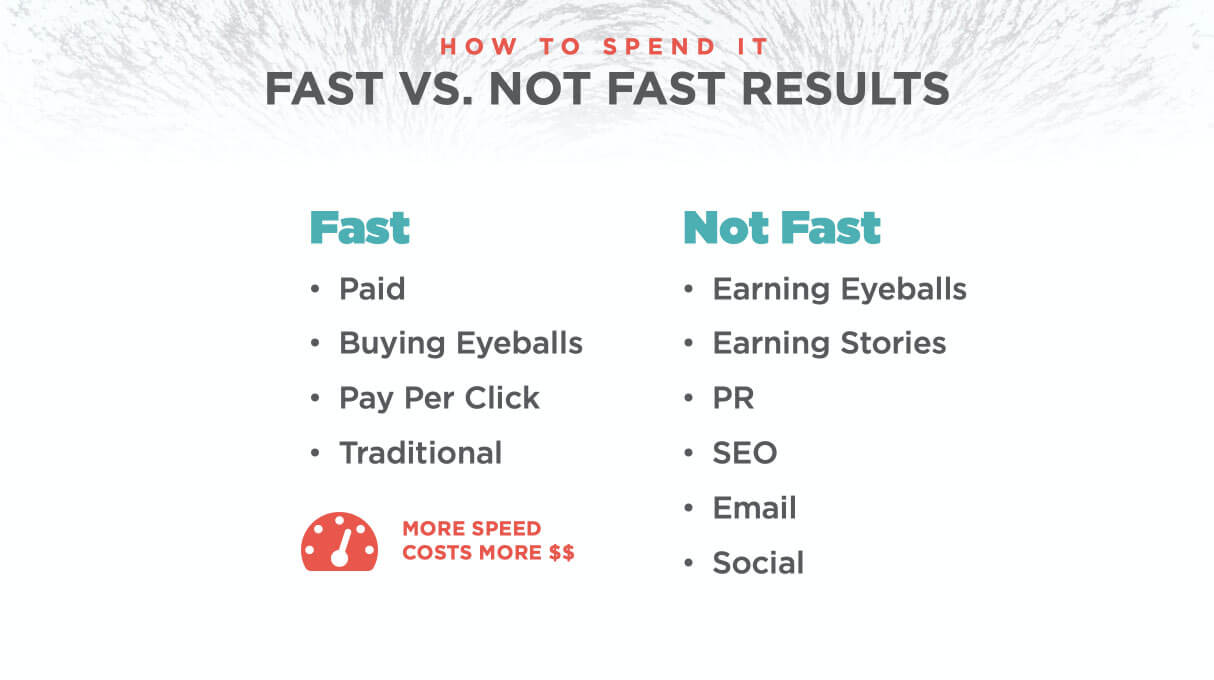
Mistake #4: Annoy, Annoy, Annoy
Meanwhile, the rest of the crowd hates you. Eek.
You will get more bang for your buck if you focus on your audience and clarify your message based on what you know about them.
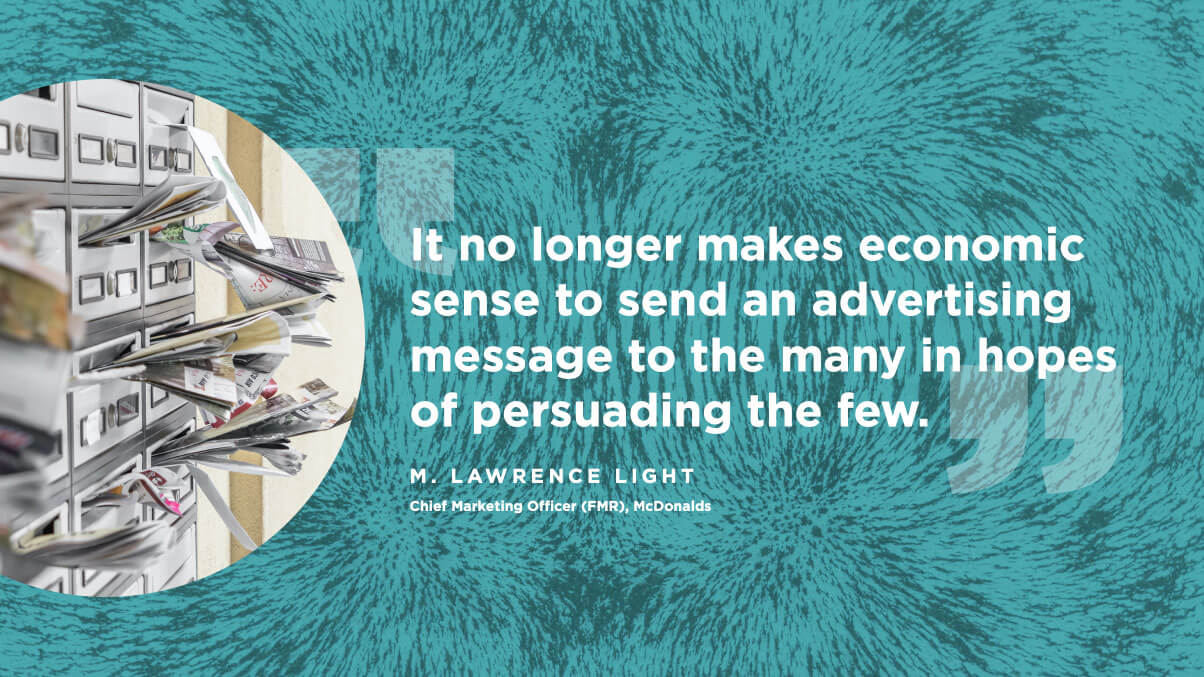
It doesn’t make sense for most brands to do a super bowl commercial.
Instead, take this same (enormous) budget, identify your persona, and be more targeted. Start small. Then grow.
Avoiding this flop begins with a good campaign strategy. Again, knowing your persona – their personal pain – and exactly how your product is going to save the day.
Our advice on this one is pretty straightforward: don’t be annoying.
Take a moment to think about what annoys you in the marketing world, like when a video about the newest minivan hijacks the screen when you’re looking at a recipe for Fettuccine Alfredo.
A few other quick reminders here:
- Don’t spray and pray.
- Segment your audience.
- Start small.
- Test early.
- Iterate often.
- Watch your ad frequency.
- Don’t be afraid to pivot entirely.
- Target based on intent, not just on demographics.
Mistake #5: Skip the Numbers
The problem? You ignored the numbers. Maybe you didn’t have the right tools set up to measure the metrics or maybe you don’t know how to decipher the data.
Analytics is constantly listed as one of the most in-demand skill sets in the marketing industry.
Meaning, the ability to decipher reports, google analytics, metrics, and numbers – and the skills to translate this information into action.
The numbers matter.
They tell us what works, what doesn’t work, how well it’s working, and ways to make it work better.
That means we have to have drivers (analytics infrastructure) in place to help us capture these numbers, plus the right people in place to turn it into actionable insights.
How can you use metrics well? Here are a few ideas:
- Establish breakpoints. For example: “If we don’t spend $1K in the first two weeks, that tells us our audience isn’t clicking on our ads, so we’ll try new ads.” Or, “If we’re getting a bunch of people to the landing page, but our conversion rate is below 2%, we need to rethink our offer.”
- Segment. Find the balance here. The best segmentation strategy is a different one for every person, but you probably don’t have the time or resources to build an individualized marketing campaign for every individual on your list. Instead, find intuitive groupings of customers based on similar interests, motivations, qualities, or behaviors – enough so that your campaign has a good shot at being effective, but not too many where you’ll never get it out the door.
- PCCPO (again). Identifying your persona(s) can help your team create excellent content and offers, which will ultimately increase your conversion rates. This is a continual learning process – campaign by campaign, creative test after creative test – where you gradually get to know what works and what doesn’t. Also, talking to your customers (actually getting on the phone and finding out why they chose you over someone else) is highly underrated.
Bonus Mistake #6: Underappreciate Copy
Yep – writing.
Sometimes it’s SEO, sometimes it’s content marketing. But consistently, year after year, word-driven tactics rise to the top.
Words really matter. The only thing our potential customers look at are art and copy.
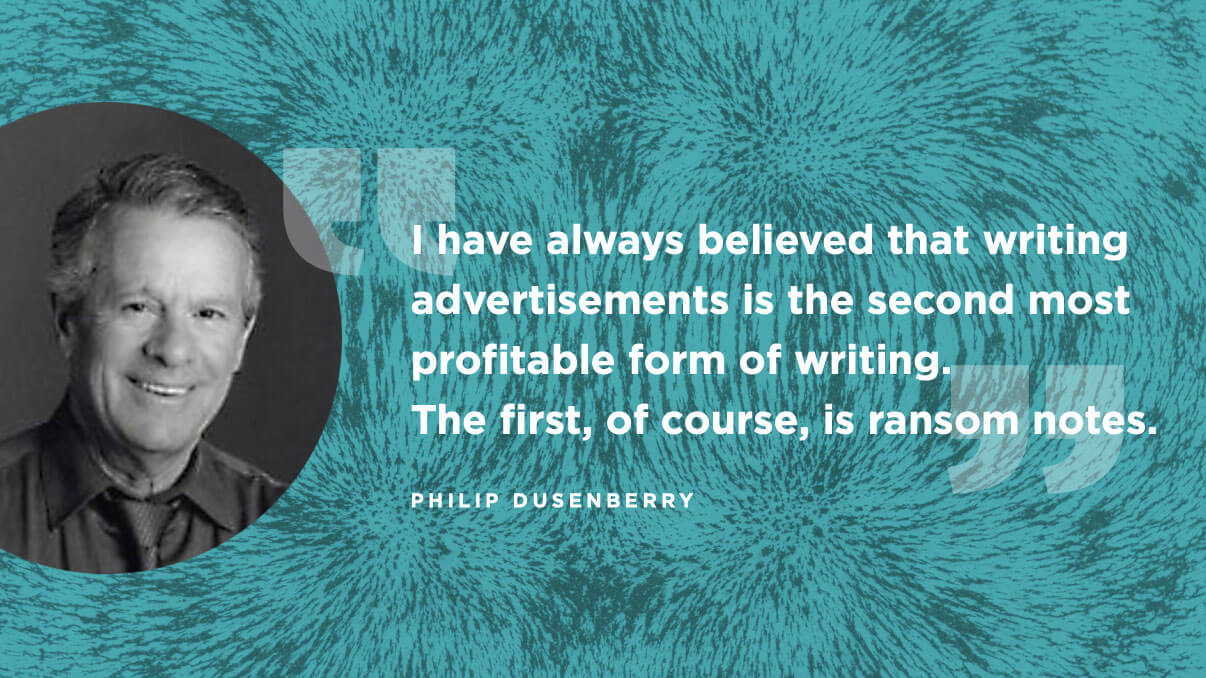
If we have lackluster writing, then everything else suffers – our product, our builders, our drivers, our conversion rates, you name it.
In the words of Howard Gossage, “Nobody reads ads. People read what interests them. Sometimes it’s an ad.”
Write well, write with intrigue, and write for your audience.
Strategy Saves the Day
You may have noticed by now that most of these marketing flops boil down to strategy (or lack thereof).
You can prevent most of these common errors by simply taking the time to know your audience and identifying a persona.
If you’re struggling with planning and launching successful marketing campaigns, check out our Campaign Strategy and Marketing Campaign Checklist for tools and tricks to help inform your next strategy session and steer clear of these common marketing mistakes.
